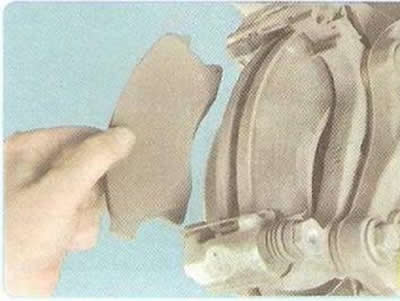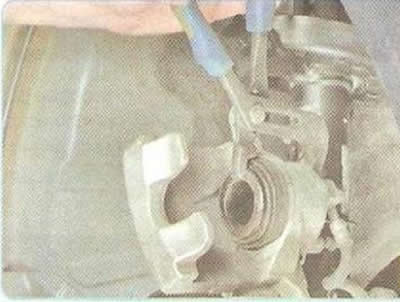Brake pads need to be replaced when the pads are worn (minimum allowable thickness of friction linings - 2 mm), loose connection of linings with the base, oiling of working surfaces, as well as in the presence of deep grooves or chips.
Warning: Replace the brake pads of the front brake mechanisms only as a set - 4 pcs. (two on each side).
Before replacing the brake pads, check the brake fluid level in the master cylinder reservoir. If the level is close to the mark «MAX», it is necessary to pump out part of the liquid (for example, a medical syringe or a rubber bulb), because after replacing worn pads with new ones, the level will rise.
1. Remove the right front wheel.

2. Turn out a bolt of fastening of the bottom directing finger of a support.

3. Raise the caliper up.

4. Remove the inner...

5....and outer brake pads.

6. Remove the lower and upper retaining springs from the shoe guide.
In order to reduce the vibration of the brake pads when the wheels rotate, retaining plates are installed in the grooves of the guide pads. When replacing pads, replace them with new ones.

7. Push the piston into the working cylinder using sliding pliers.
Helpful Hints: Every time you change the brake pads, be sure to check the condition of the protective rubber boots of the guide pin, as well as the movement of the caliper relative to the brake pad guide. If movement is difficult, grease the guide pins of the caliper. For this...

...remove the guide pin, lubricate it with grease, and then lubricate the pin guard with grease. Lubricate the second guide pin and its boot in the same way.
Install the guide pins in the reverse order of removal.
Replace the guide pin guards if they are hardened, deformed, or torn.
8. Install the fixing springs, brake shoes in the guides and other parts in the reverse order of removal. To prevent self-loosening of the caliper guide pin bolt, lubricate its threads with an anaerobic thread lock before installing.
9. Replace the left front wheel brake pads in the same way.
10. Check up and if necessary restore level of a brake liquid in a tank of the main brake cylinder.
Helpful Hints: After replacing worn-out brake pads with new ones, do not rush to immediately drive onto busy highways. It is possible that at the very first intensive braking you will be unpleasantly surprised by the low efficiency of the brakes, although the pads were branded. Brake discs also wear out, and new pads only touch them at the edges, with little to no braking. Choose a quiet street or passage without cars and slow down gently several times so that the pads get used and begin to fit the entire surface. At the same time, evaluate the effectiveness of the brakes.
Try not to brake sharply for at least the first 100 km. With strong heating of unused pads, the top layer of their linings burns and the brakes will not be as effective as possible for a long time.
